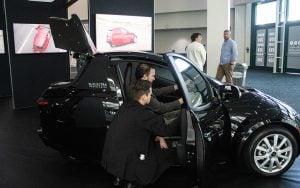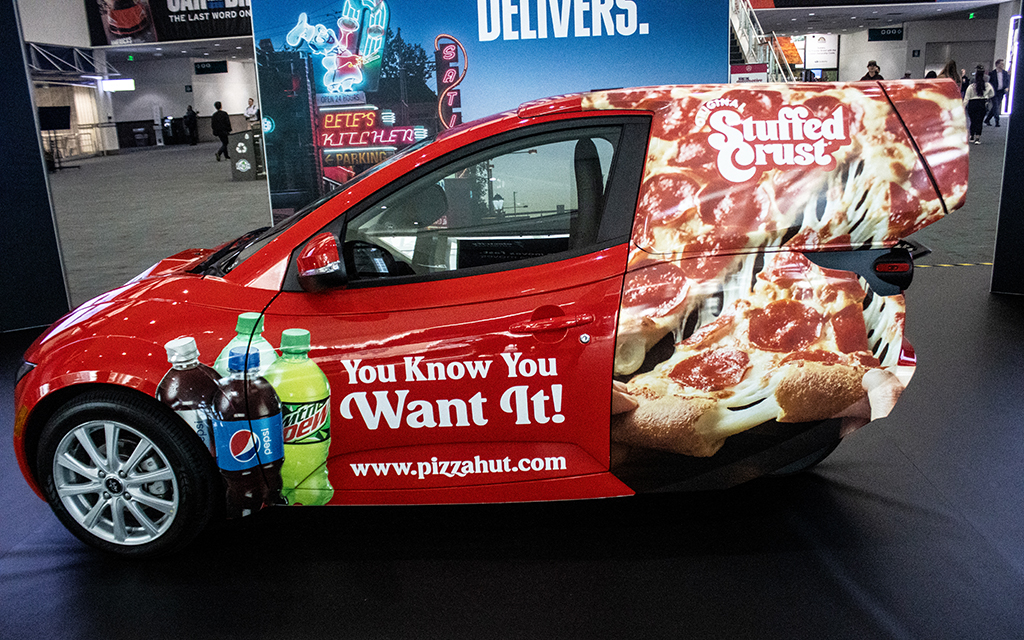LOS ANGELES – This three-wheeler could hardly be called a family car, but it’s sure to turn heads whenever it hits the road.
The ElectraMeccanica Solo is a single-seat electric vehicle that’s billed as thrifty, fun and practical. They have been imported from China, though the company opened an assembly and technical center in Mesa with the goal of building the 2023 model in the U.S.
“A lot of people travel to work by themselves, a lot of people run errands by themselves. So instead of having your four-wheel car with all the seats, you have an electric car to run all your errands,” said Cory Fullmer, ElectraMeccanica’s sales supervisor in Orange County, California, who was showing off the Solo at the Los Angeles Auto Show in November.
The Solo is certainly cheaper than a lot of conventional cars – gasoline-powered or electric. It’s priced at $18,500, and the company says it can go up to 100 miles on a single charge, be fully recharged from a standard 110-volt outlet in 15 hours and has a top speed of 80 mph. Its two-wheeled front resembles the nose of a Nissan.
Plus there’s a lot of features that can be found on a four-wheel car, including heated seats and outside mirrors, Bluetooth connectivity, air-conditioning, backup camera, remote keyless entry and power windows.
It’s also good for deliveries – at the auto show, ElectraMeccanica was demonstrating a version suited to pizzarias. The company has recently partnered with American West Restaurant Group, which says it’s the largest Pizza Hut franchisee in California and Utah.
“We did a pilot with them,” Fullmer said. “We lent them 15 of our cargo (versions) for deliveries around Southern California and it’s been nothing but successful. They love it.”
ElectraMeccanica also showed off its three-wheeler at a Pizza Hut franchisee convention recently in Dallas, he said.
As the Solo gains wider distribution, it will show just how wide the appeal is for three-wheel vehicles. Over the years, many triple-wheeled models have been proposed and some have taken the road, but none have become hits.

The ElectraMeccanica Solo is a single-seat electric vehicle imported from China and priced at $18,500. The company says it can go up to 100 miles on a single charge and fully recharge from a standard 110-volt outlet in 15 hours. (Photo by Emeril Gordon/Cronkite News)
Phoenix entrepreneur Paul Elio exemplifies the three-wheel challenges. A decade ago, his startup designed a gasoline powered vehicle – it has two seats, one behind the other – that promised 84 mpg.
Elio Motors lined up a former General Motors factory in Shreveport, Louisiana, for production, accumulated more than 65,000 reservations worth millions of dollars but had not built a single production vehicle as of late last year, USA TODAY reported. The company announced an electric version of the Elio, with a starting price of $14,900, but also warned in a Securities and Exchange Commission filing that there’s “substantial doubt” about its viability.
Another startup is Aptera Motors, based in San Diego. It plans to market what it says is a $25,900 solar-powered three-wheeled EV with a potential range of 1,000 miles per charge.
ElectraMeccanica’s Solo has the advantage of already being on the road, a transportation alternative for those who are eco-conscious, travel alone and only drive short distances.
Experts say a vehicle like the Solo can succeed, but it may have a limited number of buyers.
“I don’t think it’s going to become the next Toyota Corolla, but there is appeal,” said Brian Moody, an author at the car sales and advice site Kelley Blue Book. “It’s not a car that’s designed for a big market.”
One issue is safety – whether three-wheelers are as safe as four-wheelers. Fullmer said that ElectraMeccanica made safety a “big concern,” adding a roll bar, steel beams in the doors, crumple zones, a firewall and more.
Experts also say three-wheel vehicles can leave drivers feeling more vulnerable in traffic.
Jessica Caldwell, executive director of insights at Edmunds, noted that drivers are often distracted on freeways in large cities. She wondered whether drivers “really want to be in a small, very vulnerable type of vehicle in that type of environment?”
Plus, Americans love big vehicles. Passenger car sales continue to fall as consumers turn to pickups and SUVs, seeking extra space for camping gear, to drive across the country or the ability to pack in more passengers.
“We’ve only seen vehicle sizes grow and people buy SUVs and trucks,” Caldwell said.
And those all have four wheels.


